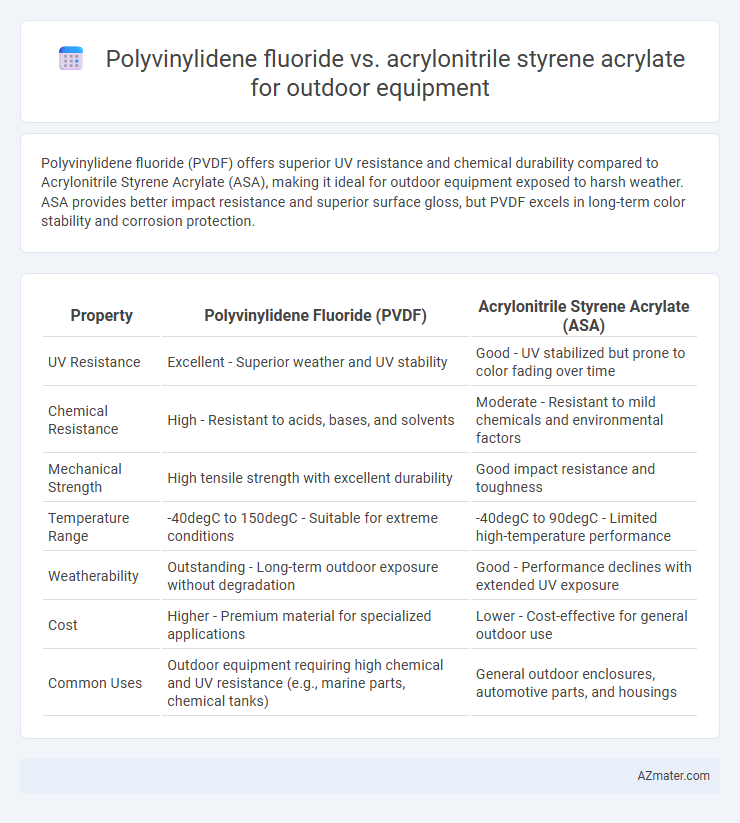Polyvinylidene fluoride (PVDF) offers superior UV resistance and chemical durability compared to Acrylonitrile Styrene Acrylate (ASA), making it ideal for outdoor equipment exposed to harsh weather. ASA provides better impact resistance and superior surface gloss, but PVDF excels in long-term color stability and corrosion protection.
Table of Comparison
| Property | Polyvinylidene Fluoride (PVDF) | Acrylonitrile Styrene Acrylate (ASA) |
|---|---|---|
| UV Resistance | Excellent - Superior weather and UV stability | Good - UV stabilized but prone to color fading over time |
| Chemical Resistance | High - Resistant to acids, bases, and solvents | Moderate - Resistant to mild chemicals and environmental factors |
| Mechanical Strength | High tensile strength with excellent durability | Good impact resistance and toughness |
| Temperature Range | -40degC to 150degC - Suitable for extreme conditions | -40degC to 90degC - Limited high-temperature performance |
| Weatherability | Outstanding - Long-term outdoor exposure without degradation | Good - Performance declines with extended UV exposure |
| Cost | Higher - Premium material for specialized applications | Lower - Cost-effective for general outdoor use |
| Common Uses | Outdoor equipment requiring high chemical and UV resistance (e.g., marine parts, chemical tanks) | General outdoor enclosures, automotive parts, and housings |
Introduction to Outdoor Equipment Material Selection
Polyvinylidene fluoride (PVDF) offers exceptional UV resistance, chemical stability, and weather durability, making it an ideal material for coatings and components in outdoor equipment. Acrylonitrile styrene acrylate (ASA), known for its strong impact resistance and color retention under prolonged sun exposure, provides a robust alternative for molded parts. Selecting PVDF or ASA depends on specific performance demands such as exposure conditions, mechanical stress, and aesthetic longevity in outdoor environments.
Overview of Polyvinylidene Fluoride (PVDF)
Polyvinylidene Fluoride (PVDF) is a highly durable fluoropolymer known for its excellent chemical resistance, UV stability, and weatherability, making it ideal for outdoor equipment exposed to harsh environmental conditions. Its low moisture absorption and strong mechanical properties ensure long-term performance without degradation from sunlight or moisture. Compared to Acrylonitrile Styrene Acrylate (ASA), PVDF offers superior resistance to corrosive agents and temperature extremes, enhancing the longevity of outdoor applications.
Overview of Acrylonitrile Styrene Acrylate (ASA)
Acrylonitrile Styrene Acrylate (ASA) is a thermoplastic polymer renowned for its excellent weather resistance, making it highly suitable for outdoor equipment exposed to UV radiation and harsh climates. ASA offers superior impact resistance, color stability, and chemical resistance compared to other plastics, ensuring long-term durability and aesthetic retention in outdoor applications. Its ability to maintain mechanical properties and resist degradation under prolonged sun exposure positions ASA as a preferred material over Polyvinylidene Fluoride (PVDF) for certain outdoor equipment requiring both robustness and visual appeal.
Weather Resistance: PVDF vs ASA
Polyvinylidene fluoride (PVDF) exhibits superior weather resistance compared to Acrylonitrile styrene acrylate (ASA), maintaining color stability and mechanical properties under prolonged UV exposure and harsh environmental conditions. PVDF's chemical structure provides excellent resistance to moisture, pollutants, and temperature fluctuations, making it ideal for outdoor equipment subjected to extreme weather. ASA, while offering good weatherability and impact resistance, tends to yellow and degrade faster than PVDF when exposed to intense sunlight and oxidative stress.
Mechanical Durability: Comparing Strength and Flexibility
Polyvinylidene fluoride (PVDF) offers superior chemical resistance and UV stability, making it highly durable for outdoor equipment exposed to harsh environmental conditions. Acrylonitrile styrene acrylate (ASA) provides excellent impact resistance and greater flexibility, which enhances mechanical toughness but is less UV resistant than PVDF. When prioritizing mechanical durability, PVDF excels in strength and long-term rigidity, while ASA is preferred for applications requiring a balance of flexibility and impact resilience.
UV Stability for Long-Term Outdoor Use
Polyvinylidene fluoride (PVDF) exhibits superior UV resistance due to its strong carbon-fluorine bonds, making it ideal for outdoor equipment requiring long-term exposure to sunlight without degradation. Acrylonitrile styrene acrylate (ASA) also offers UV stability but generally performs less effectively over extended periods, with potential surface chalking and color fading under harsh UV conditions. For applications demanding consistent mechanical integrity and color retention under prolonged UV exposure, PVDF is the preferred choice.
Chemical Resistance and Environmental Suitability
Polyvinylidene fluoride (PVDF) offers superior chemical resistance to acids, bases, and solvents, making it ideal for outdoor equipment exposed to harsh chemicals and pollutants. Acrylonitrile styrene acrylate (ASA) provides good UV resistance and weatherability but falls short in withstanding aggressive chemical environments compared to PVDF. PVDF's high environmental suitability includes excellent durability against moisture, temperature extremes, and UV degradation, ensuring longer lifespan for outdoor applications.
Aesthetics and Color Retention Over Time
Polyvinylidene fluoride (PVDF) offers superior color retention and resistance to UV degradation, making it ideal for outdoor equipment exposed to harsh sunlight. Acrylonitrile styrene acrylate (ASA) demonstrates good aesthetic flexibility but tends to fade faster and lose gloss under prolonged UV exposure. PVDF's long-lasting vibrant colors contribute to maintaining a high-quality appearance over time in outdoor environments.
Cost Efficiency and Processing Considerations
Polyvinylidene fluoride (PVDF) offers superior chemical resistance and weather durability for outdoor equipment but comes with higher material costs and processing complexity due to its high melting point and need for specialized extrusion or molding techniques. Acrylonitrile styrene acrylate (ASA) provides cost-efficient manufacturing with easier processing using standard injection molding, making it suitable for large-volume production despite lower UV and chemical resistance compared to PVDF. Choosing between PVDF and ASA depends on balancing long-term performance demands against upfront expenses and processing capabilities in outdoor applications.
Conclusion: Best Choice for Outdoor Equipment
Polyvinylidene fluoride (PVDF) outperforms acrylonitrile styrene acrylate (ASA) for outdoor equipment due to its exceptional UV resistance, high chemical stability, and superior weatherability. PVDF maintains its mechanical properties and color integrity over prolonged exposure to harsh environmental conditions, making it ideal for outdoor applications. ASA, while offering good impact resistance and UV stability, cannot match PVDF's long-term durability and resistance to environmental degradation.

Infographic: Polyvinylidene fluoride vs Acrylonitrile styrene acrylate for Outdoor Equipment
 azmater.com
azmater.com